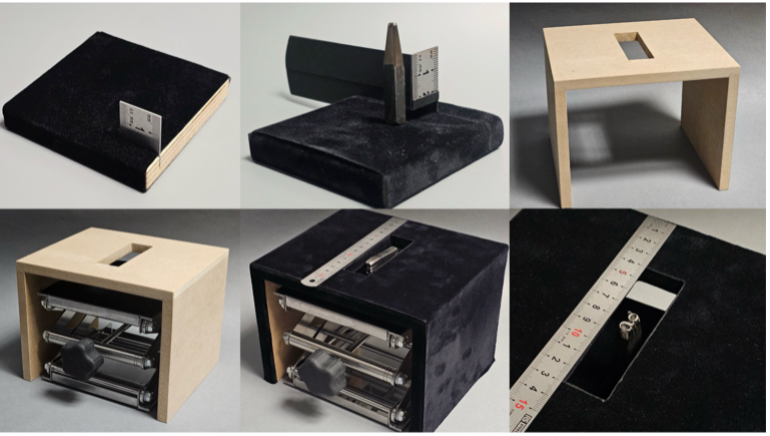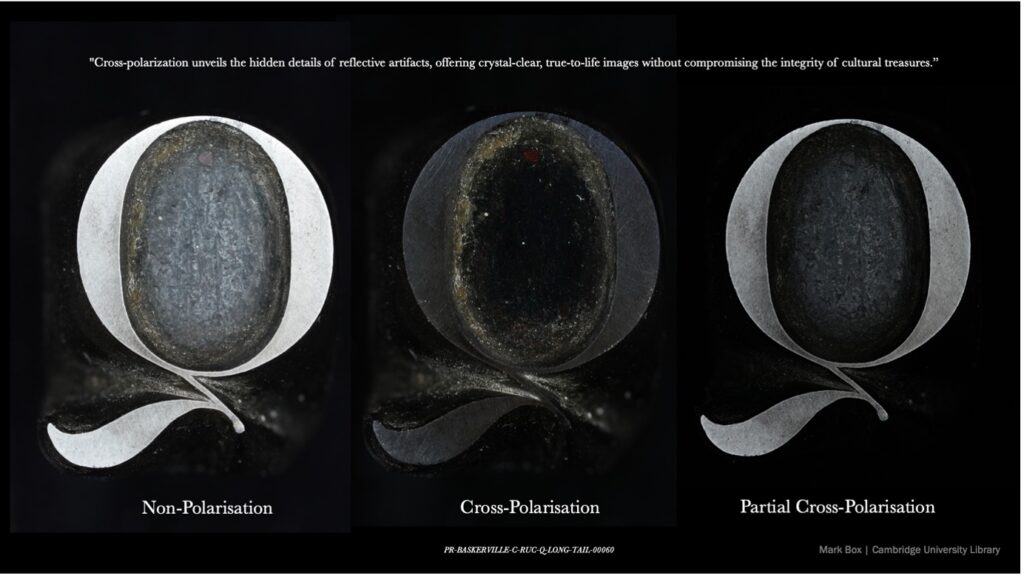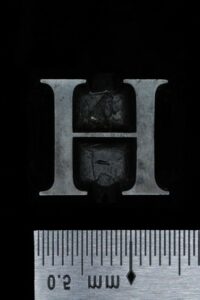Baskerville Punches are small, shiny and dark metal objects. The main body of the punch is known as the shank. The face of the punch is the side that contains the engraved design of the letter or character. This design is cut in reverse and in relief into the steel bar. For the project we tried to create a detailed record of different sides of the selected punches as they contain all kinds of maker’s marks which are significant for understanding how they were made. To do this consistently and with high level precision we had to reimagine archival photography all together. We called it Anatomical Photographs of Baskerville Punches.
To record precise measurements and positioning we first had to decide how to name and number all the sides consistently, then build the supporting structure and design a lighting rig. Finally, implement image processing which would bring the most detailed and precise representation of these tiny objects. We also had to address few challenges: how to light each punch (dark and reflective metallic surfaces), what type of measurement rule to use, and how to photograph all sides consistently.

Our first challenge was to figure out the most effective way to prop the punches so we could shoot all sides. We tested various staging platforms, from small vices to black velour paper-covered blocks, using a steel ruler for precise measurements. The solution was a custom-built open-ended box with a rectangular hole to house the punches on a raising platform. The platform allowed us to align the punch height with the steel ruler for accurate measurement. The punches are highly magnetic, so we used strong magnets covered in conservation paper to shoot them standing upright as well as flat.
In traditional reproduction photography we would use one or more diffused light sources or a photographic tent. When photographing this would create shadows, insufficient light for dark metal surfaces, and limited proximity due to the minimum focusing distance of the lens. We used a ring light flash for even illumination, but it caused overexposure and loss of detail due to reflections from the metallic surface (specifically of the typefaces). To counter this, we created a 3D-printed honeycomb filter with polarised film and added a polarised filter to the lens. Rotating these filters cancels out reflective light, a technique known as cross-polarisation, like how polarised sunglasses reduce glare on water.
This is a technique used in photography and imaging to reduce or eliminate reflections and glare from shiny surfaces. It involves using two polarising filters: one on the light source and one on the camera lens. Cross polarisation can enhance the visibility of textures and details on surfaces, making it easier to capture high-quality images of objects with reflective properties.
While setting the stage for photography we had to come with camera very close to the object. That limits how much of the punch is in focus. This is known in photography as narrow depth of field. Our solution was to use a macro lens, enabling us to get much closer to each punch. We aimed to create highly detailed images using a method known as focus stacking.

This technique uses the camera’s built-in function to take photographs in small steps focusing from the nearest surface to the furthest. These images are then combined with software to achieve full focus. Some punches need 5 stacks, while others require up to 70 images for a single focused image!



Front Focus Back Focus Full Focus
Through rigorous experimentation and dedicated research, the ‘Small Performances Project’ stood out from our previous experiences with traditional photography. We actively adapted our techniques, creating an innovative approach to capture these challenging historical objects. This contribution not only enriches the library’s resources but also supports ongoing scholarly work, ensuring that these unique artifacts are meticulously documented and appreciated by generations to come.

Anatomical shot using partial cross polarisation and focus stacking